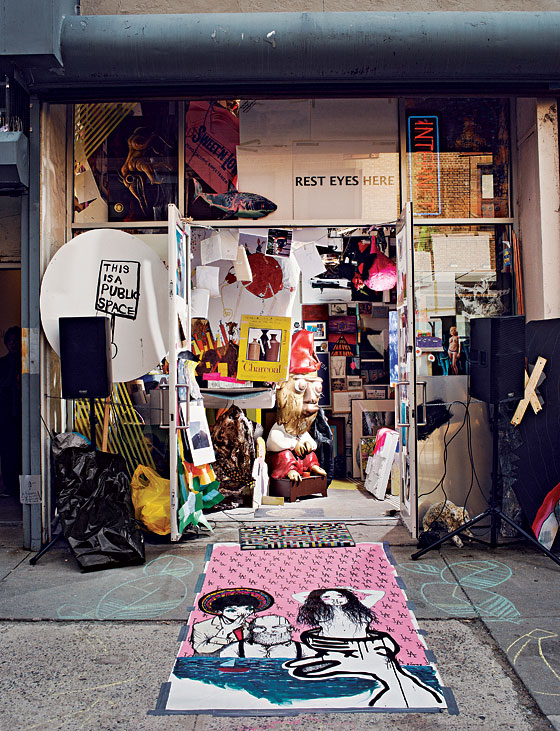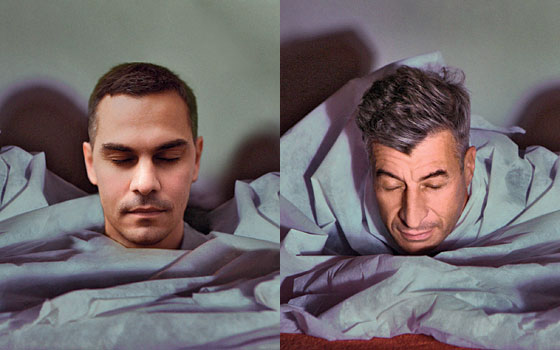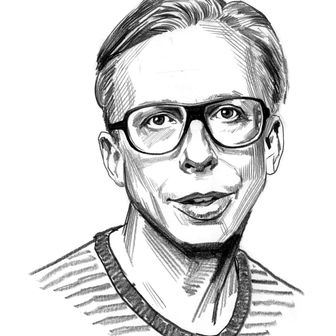
Last month, Jayson Musson, an artist best known for his YouTube performances as the droll hip-hop art critic Hennessy Youngman (“a.k.a. the pedagogic pimp”), issued an open call for a show at a tiny storefront called Family Business that had just opened amid the grand name-brand galleries of Chelsea. “Anyone, and I mean anyone, bring their work down. Bring the fucking family couch,” he said. “Bring big-ass paintings, little-ass paintings, things you painted in 1998 which is ugly as fuck … you got big-ass sculpture you want to show that won’t fit through the door, bring it down and we’ll just cut that bitch in half and reattach it when it’s back inside.”
Youngman is a vaguely Ali G–like character, though without the tightly wound British vindictiveness: He’s stoner sly, and up until a year or so ago was pretty much unknown. But his video invitation, which was viewed almost 25,000 times, spoke to art insiders and those who aspired to be—a crowd whose celebrities are art stars, power curators, and career-making gallerists. “Now, as some of you may know, Internet, the boy Maurizio Cattelan and Massimiliano Gioni have opened up a new exhibition space,” he said, wearing a cap with Pluto’s face on it, to which he’d affixed a strawlike mess so that it looked like a bowl of pasta had been dumped on his head. “Which is situated next to the motherfucking Gagosian on 21st Street.”
The boy Cattelan, 51, is an artist who, in the fall, had a career retrospective of his ironic, iconic art at the Guggenheim Museum. Gioni, 38, is the top curator at the New Museum and was recently named to run next year’s Venice Biennale, which makes him, in this world, a tastemaker’s tastemaker. “They’re bosom buddies. Top of the food chain,” says Musson, when I visit him while he’s trying to hang the nearly 500 oddball, often porn-y works of art that spilled out onto the sidewalk (and yes, someone brought a sofa). “With Maurizio’s affiliation with it, since he’s sort of a clown, I thought it would be funny to do something ridiculous or something doomed to fail.”
But there’s a yearning behind this clowning. For Cattelan and Gioni, Family Business is an earnest prank, an altruistic carnival. Cattelan and Gioni are both known for their sense of humor and felicity with publicity. But their days of hanging out looking at art together, as outsiders, are long since over, and it’s difficult to thumb your nose at the art-world Establishment when you’ve been embraced by it.
Boxed out by his own success, Cattelan—whose works sell for millions—decided to retire after the Guggenheim show. Making art wasn’t as much fun anymore, it seems. In December, he persuaded Gioni to go in with him on a new venture, Family Business. It’s not exactly a business—it doesn’t sell work—but a working monument to a way of doing business that got them to where they are: a small mafia of subversive co-conspirators. Unlike, say, the branch office of Gagosian next door—the global Goldman Sachs of the art world, where everything is exactingly vetted for collector value—it’s designed for them not to be directly involved at all, at least on the curating level. As an experimental space fueled by their own blue-chip reputations, it’s in many ways an act of optimistic nostalgia—an effort to recapture their outsider status, or at least give them access to that of others. And designed to be hijacked by those outsiders, who want what they have. While they watch, amused.
“Oh, you want to hear the whole legend,” says Gioni. We’ve met for dinner at Tenth Avenue’s Cookshop, the hectically slick gallery-district cafeteria. It took some back and forth with his busy schedule to get both him and Cattelan here.
Both Gioni and Cattelan grew up working-class Italians, though Gioni is the more educated of the two (he loves Sonic Youth and can recite by heart the dissociative Dadaist text Manifesto of Mister Antipyrine). He met Cattelan when interviewing him for the magazine Flash Art in 1997. Cattelan’s career was beginning to take off then (a project he was conceiving at the time: having people wearing oversize Picasso heads hang out at the Museum of Modern Art), and he asked Gioni to do a radio interview, pretending to be him. “He said, ‘I’ll give them your number, and they’ll call you.’ And then it kind of escalated. It started as a form of problem solving. He didn’t like to talk; I guess I like to talk too much,” Gioni says, laughing. The role-playing was meant to undermine certain expectations of what is real, but Gioni’s explanations of Cattelan’s often very weird and vaguely allegorical art (like a sculpture of an elephant in a Klan uniform) helped give it a certain seriousness. The alliance made Gioni well known and Cattelan more easily comprehensible. “He was more famous, so it became some sort of propaganda for me,” Gioni says, smiling. “It was very hard. I had to make two names for myself, my own and his.” He laughs.

“How lucky Maurizio is that he met Massimiliano,” says curator Ali Subotnick, who for a while was the third member of their New York art family. “They complement each other. They could finish each other’s sentences.”
“Maurizio was the person in the late nineties who’d seen every single show. He’d go around on his bicycle,” says Tom Eccles, who runs the curatorial school at Bard College but was then in charge of the Public Art Fund in the city. “He was an information addict. It’s easy to forget, now that he’s entered a certain place—as a kind of international art star—that he’s always been trying to find avenues to bring in others, to give them opportunities. He’s never been a Damien Hirst, who is about Damien Hirst.”
Gioni, Cattelan, and Subotnick joked about starting a magazine and then launched Charley, which began as a compilation of 400 artists they and their friends found interesting. They talked about how much fun it would be to have their own gallery, and Cattelan found a forlorn doorway in Chelsea and persuaded the owner of the building to let them use it. They called it, sportively, the Wrong Gallery: It had one and a half square feet of exhibition space. “And then artists started coming to us,” says Subotnick, on Bluetooth as she drives through Los Angeles to her job at the Hammer Museum (her career took off thanks to the collaboration, too). “They appreciated the playfulness and working with limitations.” Major names like Martin Creed, Paul McCarthy, Lawrence Weiner, and many others exhibited there; once they just posted a sign that read FUCK OFF, WE’RE CLOSED (it was an artwork by Adam McEwen). After the building was sold, the Wrong Gallery moved to the Tate Modern in London, where Gioni and Cattelan would sometimes stash a piece from that museum’s permanent collection behind the door, and sometimes curate something original. “It was a space where there was no space,” says Gioni, curating the concept for me. “It’s just a door.”
The Wrong Gallery got Gioni (who’d already overseen a small pavilion at Venice) the job heading the public-art Trussardi Foundation in Milan (where he exhibited a notorious Cattelan piece consisting of three mannequins of boys strung up by their necks from a tree). It also got him nominated to run the Berlin Biennale in 2006. When he brought along Cattelan and Subotnick, the three of them got the gig. One of their Biennale’s most memorable features was a space they named, as a send-up, the Gagosian Gallery Berlin. After Berlin, Gioni was too well known to continue going around pretending to be Cattelan (plus they nearly got a TV reporter from Sweden fired for pulling that stunt). Their careers separated. Subotnick moved to L.A.
But there is supposed to be a point to all of this, they tell me. “Nobody is just himself or herself,” says Gioni, speaking in his elliptical way about the nature of collaboration. “Everybody comes with luggage and connections. You don’t know where you end and somebody else starts.
“And this is, in a way, what the space is about: hospitality or parasitic relationships. And families are parasites, for better or worse, you know?” He pauses over his lamb. “Or symbiotic maybe better than parasitic, you know?”
Family Business came about so quickly that Gioni calls it “an open-air pregnancy. It’s not born yet, and yet you can still see it.” Cattelan was looking to see what was next for him if he wasn’t making art any longer. (“I have no more jokes,” he told Eccles.) The photographer Marilyn Minter, at a dinner, suggested he teach; she’s taught for years, at Yale and SVA, and enjoys it. At the same time, a gallerist he knows, Anna Kustera, had offered him use of the front of her space on the ground floor of a West 21st Street building. “I would always say, ‘Why don’t you use this window? This is the best asset of the gallery,’ ” Cattelan says. “And she said, ‘Why don’t you do something?’ ”
After Cattelan persuaded Gioni to join the project over lunch in December, they recruited Eccles, who arranged for Bard to provide the nonprofit infrastructure and sign the three-year lease. (He’d previously done the same thing for the Wrong Gallery when he ran the Public Art Fund.) Cattelan paid for the drywall to subdivide the space. Minter, a sprightly 63, agreed to curate the first month—her overarching theme was “Virgins,” or artists who hadn’t shown before; the band the Virgins played the first night’s after-party. They hired a 25-year-old Russian SVA student, Daria Irincheeva, to be their director; her first show, “Toasting to the Revolution,” is of six friends from back home, commenting on life under Putin.
“For me, it’s a way to look somewhere I’m not looking,” says Gioni. “One great quote from Maurizio that I made up is that you cannot go everywhere with a big car or a limousine. You need a bicycle to get to interesting places. In a way, you know, Family Business is the bicycle.”
“It’s a way to get back to the playfulness and energy without the huge bureaucracy behind it,” says Subotnick, who is slogging through curating a new biennial at the UCLA Hammer Museum, opening this June.
Family Business is also a reminder of the will to be noticed that they had when they started out. Now others have it. Cattelan went by on the drop-off day for Musson’s show and found it “insane,” much to his fascination. “People lined up like they’re looking for a job, with canvases under their arms. This is a fantastic image on 21st Street. You live the dream.”
Something about that picture of ambition makes Gioni the curator uncomfortable. “I don’t like the idea that there is a winner,” he says. “I think that is not very interesting.
“But you live a dream anyway. Because this is New York.”
Then there is—as a consequence of achieving your dream—the nightmare Gioni calls “paranoia mind”: “When you are so alienated from creative ideas that you only find ideas at the Armory art fair. A lot of good art happens outside of the channels you know. And part of the beauty of art is that it creates a new territory by its own appearance. So you have to be alert for situations where you can see what you don’t know. I don’t know if Family Business is that place.”
“It’s one of the places where it could happen,” Cattelan says.
“It’s also nice—it’s also about having a place that we run for other people,” Gioni says.
“And every two weeks there is an event,” Cattelan says.
“We have more openings than shows,” says Gioni, laughing. “We bypass the show problem. We go straight to the opening.”
At 7 p.m. the night of Musson’s opening, there is already a crowd milling about when Cattelan arrives. There was no way to get anywhere near the gallery entrance. “It’s like a street fair,” he says, marveling at what the G-to-the-L train disgorged onto the street—cleverly coiffed boho youth smoking and taking one another’s pictures with their iPhones. Cattelan is in a suede jacket and gleaming shoes, his pink shirt collar turned up. He looks like an elegant tourist, overdressed a bit for his own past life.
Across the street, a young guy with a pierced tongue and in a baggy vintage suit who came up from Philadelphia was standing in front of a rattling generator and lights, announcing, through a megaphone, that he had temporary tattoos available. They said 15 minutes of fame. Someone had made T-shirts with the Family Business logo written like an Italian restaurant, complete with a chef giving the okay sign.
Marilyn Minter was ecstatic. Musson’s show was the “Virgins” finale. She’d just found him on the Internet. (Musson, for his part, calls her a “goddess.”) “Everything has been spontaneous,” she says, as she got her temporary tattoo impressed on her arm. “Everyone has chipped in money. For the sound system. For beer. I was around in the eighties when we had openings till two in the morning in the East Village. But there were massive amounts of drugs and half the people are dead.” She laughs, amazed and defiant, and looks around. “I think in the history of art there have always been these moments. As soon as things are nailed down, there are the outbursts of cacophony. And things are really nailed down right now.”
Earlier, Cattelan told me, “I don’t want to say it’s against corporations, because I don’t think I would call it the 99 percent gallery. But it’s something to remind us that there is not only one way to present art in this neighborhood. It would be more expected in Greenpoint.”
It would also be more authentic: In some ways, Family Business is a captured alternative scene, an experiment for those uncomfortable with their comfort. But it is also really fun. Eccles found it “refreshing” that he knew so few people at the opening he attended: “Fantastic, I thought. And they seemed to think that they owned the place.”
Musson is trying to get Cattelan to pose on a makeshift red carpet by the gallery, next to a poster-size photo of a vagina. Cattelan ducks away. When the guy with the fake tattoos tries to get Cattelan to get one, he demurs. “I want to be the last one,” he says, turning to Minter, delighted, but trying to muffle it.
“We’ll never do another event like this,” he says, while a cab honks its way through, and two men, dressed identically in suits and wearing stockings over their faces, walk by, artistically. The dissonant hip-hop group Spank Rock is setting up to rap on the sidewalk in front of the overstuffed gallery, its doors open to the street. “You can do it once, but if you try to do it again, it won’t work.”
